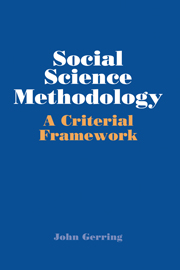Book contents
6 - Description and Prediction
Published online by Cambridge University Press: 05 June 2012
Summary
What the devil is going on around here?
–Abraham KaplanIn Chapter 5, I argued that all empirical propositions are liable to ten general criteria of adequacy – specification, accuracy, precision, breadth, depth, parsimony, analytic utility, innovation, relevance, and intelligibility. It is readily apparent that most propositions have more work to do, even once they have satisfied these basic criteria. Indeed, the main purpose of some propositions is not even broached in the foregoing desiderata. In order to understand these additional demands we must differentiate among four types of assertion: generalization, which seeks to describe, and perhaps interpret, an event or class of events; classification, which seeks to place diverse events within a related set of categories; prediction, which seeks to tell us something about a future state of affairs, or a past state of affairs which is not yet known (post-diction); and causal inference, which seeks to explain why something occurred, or will occur. The first two categories will be referred to as descriptive. These five key terms, together with illustrative examples, are arrayed in Table 6.1. This chapter deals with descriptive and predictive propositions. The following chapter takes up the more complex question of causal inference.
Description
Generalization
The simplest sort of proposition we can make about the world is factual. Caesar crossed the Rubicon in 49 b.c.; Columbus sailed the ocean blue in 1492; the Japanese attacked Pearl Harbor on December 7, 1941. I do not mean to imply that such statements are unproblematic.
Information
- Type
- Chapter
- Information
- Social Science MethodologyA Criterial Framework, pp. 118 - 127Publisher: Cambridge University PressPrint publication year: 2001
Accessibility standard: Unknown
Why this information is here
This section outlines the accessibility features of this content - including support for screen readers, full keyboard navigation and high-contrast display options. This may not be relevant for you.Accessibility Information
- 1
- Cited by
